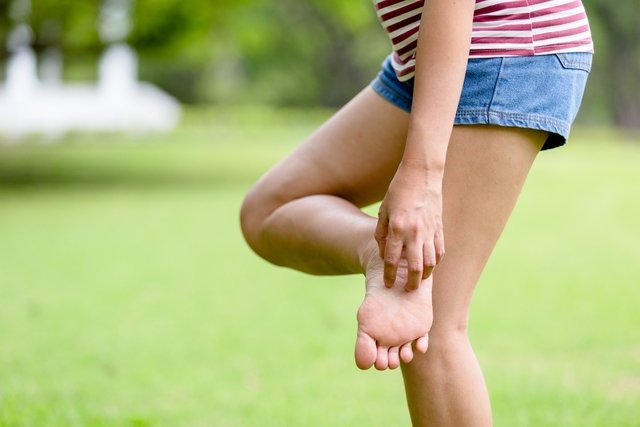Itchy feet are usually caused by dry skin, and can become more common during the winter. Another common cause of itchy feet is excessive fungal growth in the feet. This condition can be treated with antifungals as prescribed by your doctor or dermatologist.
Itchy feet can also be caused by less serious problems, like allergies, psoriasis or even bad circulation. It is often associated with other symptoms, which upon evaluation, will help to determine the underlying cause and guide treatment.
If you notice itchy feet and if they are accompanied by additional symptoms, like pain, redness, flaking skin, and swollen feet or ankles, you should see a family doctor or dermatologist for a complete evaluation and targeted treatment.

What causes itchy feet?
The 10 most common causes of itchy feet include:
1. Dry skin
Feet are prone to becoming dry easily because this area of the body does not contain sebaceous glands. It is also not usually an area that people remember to hydrate often. Dry skin on the feet can lead to intense, persistent itching if not adequately treated.
How to treat: Treatment for dry skin is simple and consists of applying moisturizing cream on the feet daily after showering. Ideally, you should apply nutrient-rich creams with urea or salicylic acid, which will also help to remove any dead skin cells.
2. Peripheral neuropathy
Peripheral neuropathy is a combination of changes that affect nerves throughout the body. Associated symptoms include pain, tingling, weakness, lack of sensitivity in some areas, and itching. This condition is generally a result of diabetes, leprosy, severe malnutrition or autoimmune disease.
Also recommended: Diabetic Neuropathy: Symptoms, Types, Causes & Treatment tuasaude.com/en/diabetic-neuropathyHow to treat: Treatment is completed based on the presenting symptoms of each person. Doctors may prescribe analgesics to help with pain, like acetaminophen, or medication to help with sexual dysfunction, like sildenafil. In addition, physiotherapy to help rehabilitate affected areas may also be recommended.
3. Psoriasis
Psoriasis is a skin illness that cause symptoms like red rashes, dry or scaling patches of skin, and itching. Read more about what causes psoriasis and other symptoms associated with it.
How to treat: Psoriasis does not have a cure, but it can be treated with creams and ointments as well as oral immunosuppressants and anti-inflammatories. Some people may benefit from UV skin treatments. Maintaining a psoriasis diet can also help to manage symptoms.
4. Athlete's foot
Athlete's foot, also known as tinnea pedis, is a type of fungal skin infection. It is usually caused by the Trichophyton, Mycrosporon or Epidermophyton fungi, which mainly affect the bottom of the feet or the space between the fingers. Symptoms include intense itching and peeling.
Read more about the symptoms of athlete's foot and what can cause it.
How to treat: Treatment for athlete 's foot consists of the application of antifungal creams or ointments directly to the affected areas. Commonly prescribed topicals include clotrimazole or miconazole. If topical medications are not sufficient, the doctor may also need to prescribe oral itraconazole or fluconazole, to be taken for 3 months. It is also necessary to wash the feet daily and avoid moisture, which can worsen the infection and prolong treatment.
5. Tunga penetrans
Tunga penetrans is a type of flea that burrows in the skin, most commonly the feet. It can grow and develop rapidly and lead to symptoms like pain, itching and redness.
How to treat: To treat this infection, this flea needs to be removed at a health center by a health care professional. The doctor may advise the use of camphor-based creams or vaseline to facilitate treatment. If the infection has caused many wounds, anti-parasitics like tiabendazole or ivermectin are indicated.
5. Skin reaction
A skin reaction is characterized by an inflammatory response that can cause symptoms in many parts of the body. A reaction can be triggered by make-up, medications, the sun or insect bites and common symptoms include itching, redness, skin peeling, irritation and the presence of rashes or red or white blisters.
How to treat: Generally, reactions are treated with anti-histamines like loratadine or cetirizine. They can also be treated with corticosteroids, like betamethasone, which help to relieve allergy-related symptoms. You should also avoid use of the trigger.
7. Poor circulation
Poor circulation consists of decreased blood flow through the vessels, and is associated with symptoms like cold hands, swollen feet, tingling and itchy feet or legs. It can also cause leg pain and the emergence of varicose veins.
Also recommended: Poor Circulation in Legs: Symptoms, Causes & Treatment tuasaude.com/en/poor-circulation-in-legsThis problems is most frequent in women, and can become more intense during pregnancy. Women will often notice increased swelling in the feet during this time.
How to treat: To improve blood circulation, you should exercise often, use compression stockings, avoid prolonged sitting or standing, reduce your salt intake and maintain an ideal weight. Check-out other natural remedies for circulation that you can prepare at home.
8. Dyshidrosis
Dyshidrosis can cause the emergence of small, fluid-filled blisters on the palms of the hands or bottom of the feet. These blisters are most seen on the sides of the fingers and can cause intense itching that lasts for up to 3 weeks. It is most common in the summer with temperature increases, or during episodes of emotional stress. Although the exact cause is not well-known, it is thought to be associated with contact or atopic dermatitis.
How to treat: To treat dyshydrosis, the dermatologist can recommend topical steroid creams like clobetasol or methylprednisolone. They can also prescribe oral steroids if topical creams are not effective or in more severe cases.
9. Cutaneous larva migrans
Cutaneous larva migrans is caused by several types of hookworms that are found in dirt that is contaminated by infected stool (usually of cats or dogs). These hookworms enter the skin through small wounds and can cause intense itching and red wound that wrap around the affected area. The most commonly affected body parts are the feet, legs and hands.
How to treat: Treatment for cutaneous larva migrans is completed with antiparasitics, like tiavendazole creams, applied to the wounds, or oral albendazole or mebendazole for larger wounds.
